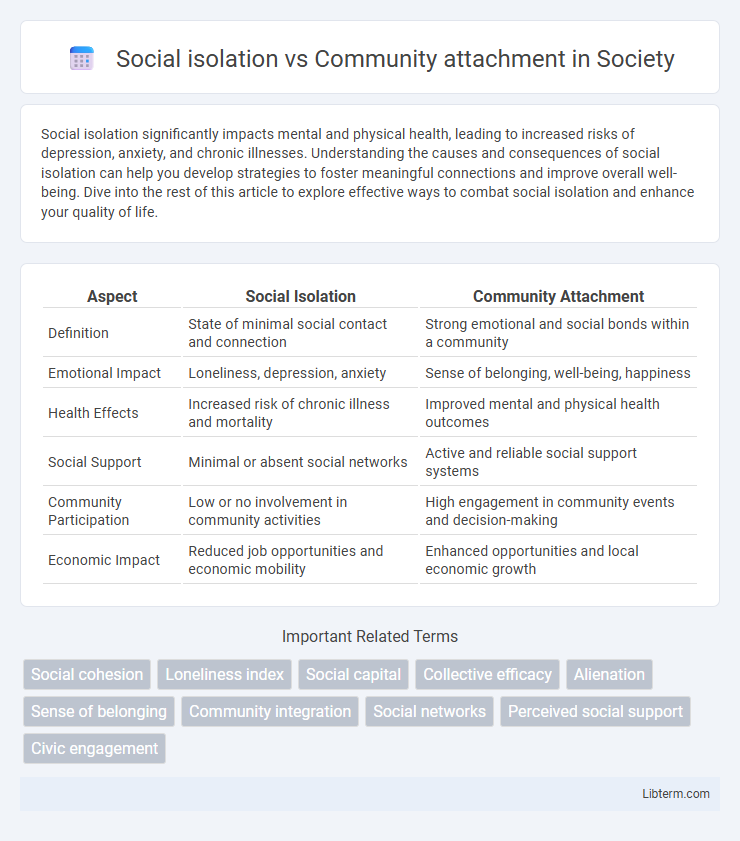Social isolation significantly impacts mental and physical health, leading to increased risks of depression, anxiety, and chronic illnesses. Understanding the causes and consequences of social isolation can help you develop strategies to foster meaningful connections and improve overall well-being. Dive into the rest of this article to explore effective ways to combat social isolation and enhance your quality of life.
Table of Comparison
| Aspect | Social Isolation | Community Attachment |
|---|---|---|
| Definition | State of minimal social contact and connection | Strong emotional and social bonds within a community |
| Emotional Impact | Loneliness, depression, anxiety | Sense of belonging, well-being, happiness |
| Health Effects | Increased risk of chronic illness and mortality | Improved mental and physical health outcomes |
| Social Support | Minimal or absent social networks | Active and reliable social support systems |
| Community Participation | Low or no involvement in community activities | High engagement in community events and decision-making |
| Economic Impact | Reduced job opportunities and economic mobility | Enhanced opportunities and local economic growth |
Understanding Social Isolation
Social isolation refers to the lack of social connections and meaningful interactions, which negatively impacts mental and physical health. Understanding social isolation involves recognizing factors such as loneliness, limited social networks, and reduced participation in community activities. Community attachment serves as a protective factor by fostering social bonds, providing emotional support, and enhancing overall well-being.
Defining Community Attachment
Community attachment refers to the emotional connection and sense of belonging individuals feel toward their local community, which fosters social cohesion and collective identity. Strong community attachment enhances residents' well-being by promoting participation in communal activities and mutual support networks, thereby reducing feelings of social isolation. Measuring community attachment involves assessing factors such as trust in neighbors, satisfaction with local amenities, and commitment to the community's future.
Causes of Social Isolation
Social isolation often stems from factors such as physical disabilities, mental health issues, aging, and geographic remoteness, which limit individuals' ability to engage with others. Economic hardships, lack of transportation, and technological barriers further exacerbate isolation by reducing access to social networks and community resources. Weak community infrastructure and limited social programs contribute to diminished opportunities for meaningful social interactions and community attachment.
Benefits of Strong Community Bonds
Strong community attachment improves mental health by reducing feelings of social isolation and loneliness, which are linked to depression and anxiety. Individuals embedded in tight-knit communities experience increased emotional support, enhanced sense of belonging, and greater access to resources during times of need. Research shows that robust social bonds promote resilience, physical well-being, and overall life satisfaction by fostering trust, cooperation, and shared identity among members.
Psychological Impacts: Isolation vs Attachment
Social isolation is linked to increased risks of depression, anxiety, and cognitive decline due to the lack of social interaction and emotional support. In contrast, strong community attachment fosters a sense of belonging, enhances self-esteem, and provides emotional resilience against stress. Research highlights that individuals with robust social networks experience lower rates of psychological distress and improved overall mental health outcomes.
The Role of Technology in Social Connections
Technology significantly influences social connections by both alleviating social isolation and enhancing community attachment through digital platforms and social networks. Virtual communication tools like video calls, social media, and online communities provide accessible means for individuals to maintain relationships, especially for those with physical or geographical barriers. However, excessive reliance on technology may sometimes hinder face-to-face interactions, highlighting the need for balanced use to foster genuine community bonds and emotional support.
Social Isolation Across Different Age Groups
Social isolation disproportionately affects older adults, with studies showing that nearly 25% of individuals aged 65 and above experience significant social isolation, leading to increased risks of depression, cognitive decline, and mortality. In contrast, younger age groups, such as adolescents and young adults, report lower but rising levels of isolation, often linked to digital communication replacing face-to-face interactions. Community attachment acts as a protective factor across all ages, fostering social support networks that enhance mental health and resilience against the adverse effects of isolation.
Building Community: Strategies and Initiatives
Building community involves fostering strong social networks through initiatives such as neighborhood events, support groups, and collaborative projects that encourage regular interaction and shared goals. Strategies like creating inclusive public spaces, promoting cultural activities, and facilitating digital platforms help counter social isolation by enhancing community attachment and a sense of belonging. Effective community-building initiatives prioritize accessibility, diversity, and sustained engagement to cultivate resilient social ties and improve overall well-being.
Overcoming Barriers to Community Attachment
Social isolation often stems from barriers such as limited access to social networks, physical disabilities, or cultural differences that hinder community attachment. Overcoming these obstacles involves creating inclusive programs that foster social engagement, providing accessible public spaces, and promoting community initiatives that celebrate diversity. Enhancing community attachment reduces feelings of loneliness and supports mental health by strengthening interpersonal relationships and shared identity.
Fostering Resilience through Social Networks
Social isolation significantly undermines mental and physical health, while community attachment strengthens resilience by providing emotional support, shared resources, and a sense of belonging. Robust social networks facilitate coping strategies during stress, reduce feelings of loneliness, and enhance overall well-being. Research shows that individuals embedded in strong community ties exhibit lower risks of depression and faster recovery from adversity.
Social isolation Infographic

 libterm.com
libterm.com